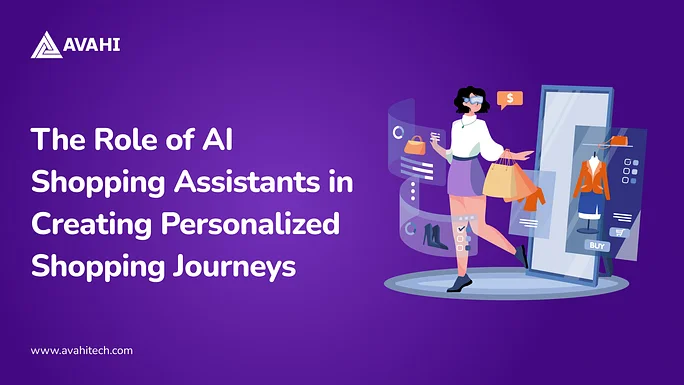Imagine having a sales assistant who works 24/7, instantly understands each customer’s preferences, never gets tired, and keeps improving with every interaction.
Now, picture deploying that assistant across your website, mobile app, and in-store kiosks without hiring more staff. That’s the power of AI shopping assistants.
Today’s consumers expect personalization as a baseline, not a bonus. A McKinsey report reveals that businesses using AI-driven personalization increase revenue by up to 40%. At the same time, a Salesforce survey shows that 66% of customers expect companies to understand their needs and expectations. Yet many retailers still struggle to deliver this tailored service at scale.
You’re competing not just on product or price but also on experience. And AI shopping assistants are quickly becoming critical to delivering that experience at scale. Whether a virtual stylist recommending outfits based on a shopper’s body type or a conversational chatbot guiding a first-time buyer through complex product categories, AI tools are redefining how customers interact with brands.
This blog will explain how AI shopping assistants work, which technologies drive them, real-world examples proving their ROI, and the opportunities (and ethical questions) they present.
From Data to Decisions: Core Technologies Powering AI Shopping Assistants
AI shopping assistants are intelligent digital agents that assist consumers in shopping by providing personalized recommendations, answering queries, facilitating transactions, answering questions in real time, and guiding users through the buying process.
Unlike basic chatbots that follow scripted responses and have limited understanding, AI shopping assistants use machine learning and natural language processing technologies to interpret user intent, learn from behavior, and deliver dynamic, context-aware interactions.
This makes them more adaptive, proactive, and capable of providing tailored support throughout the shopping journey. Here are some of the main technologies that help AI shopping assistants work effectively:
1. Natural Language Processing (NLP)
Natural Language Processing enables AI systems to interpret and respond to human language inputs. This is essential for allowing users to interact with shopping assistants through text or voice in a natural, conversational way. For instance, users can request “waterproof hiking shoes under $80” without using specific keywords or filters.
A practical example is Google’s AI Mode, which uses NLP to process user queries in everyday language and return highly relevant results. Combining semantic understanding with structured product data allows the assistant to refine search results and support follow-up questions during shopping.
2. Machine Learning (ML)
Machine Learning algorithms identify patterns in user behavior, such as browsing history, click-through rates, and past purchases, and use this data to generate personalized product recommendations. The system continuously updates its understanding of user preferences, improving the relevance of future suggestions.
Amazon’s “Interests” Tool uses ML models that classify user-defined preferences and dynamically match them with appropriate items in Amazon’s vast catalog. This allows the platform to deliver product alerts that align closely with evolving customer interests, without requiring manual searches.
3. Computer Vision
Computer Vision allows AI systems to process and interpret images or video content. In retail, it powers capabilities like visual search, where users upload photos to find visually similar items, and virtual try-on tools, which overlay product images on live or static user images for a more immersive shopping experience.
For example, Google’s Shopping AI integrates Computer Vision with its Shopping Graph, enabling visual search tools that identify products based on uploaded pictures or screenshots. This helps users discover items when they don’t know the exact product name or category.
4. Generative AI
Generative AI systems generate human-like content using transformer-based models (like GPT -44). In shopping assistants, this includes composing product descriptions, summarizing reviews, and answering product-related queries with context-aware responses. These models also support dynamic conversation, helping guide users through multi-step shopping processes.
The Importance of Personalization in Modern Retail
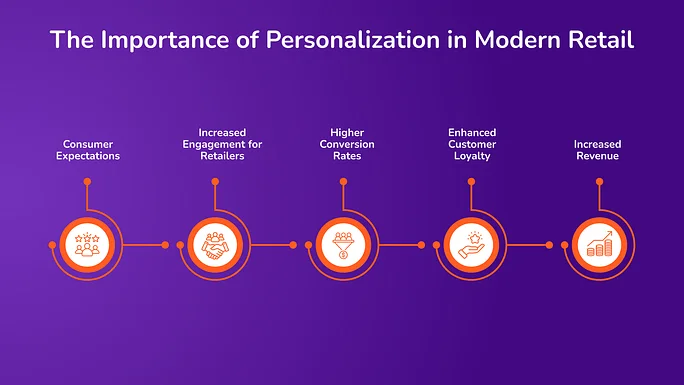
Personalization has become a fundamental aspect of modern retail, driven by evolving consumer expectations and the need for businesses to differentiate themselves in the market. Here’s an in-depth look at its significance:
1. Consumer Expectations
Today’s consumers anticipate shopping experiences that are tailored to their individual preferences. They expect retailers to understand their needs and offer relevant product recommendations, promotions, and content.
A failure to meet these expectations can lead to customer dissatisfaction and loss of business. According to a McKinsey report, 71% of consumers expect companies to deliver personalized interactions, and 76% become frustrated when this doesn’t occur.
2. Increased Engagement for Retailers
Personalized experiences can significantly boost customer engagement. By presenting relevant products and content, retailers can more effectively capture shoppers’ attention, leading to longer browsing times and increased interaction with the brand.
3. Higher Conversion Rates
Tailored recommendations and personalized marketing messages can lead to higher conversion rates. When customers see products and offers that align with their interests and needs, they are more likely to purchase. Research indicates that personalization can lead to a 10-15% boost in sales conversions.
4. Enhanced Customer Loyalty
Personalization promotes a stronger connection between the customer and the brand. When shoppers feel understood and valued, they are more likely to return for future purchases, increasing customer retention and loyalty. Personalized experiences can increase customer satisfaction rates by 20% and increase customer lifetime value.
5. Increased Revenue
Implementing AI-driven personalization strategies can substantially impact a retailer’s bottom line. Retailers that effectively utilize personalization have been shown to drive as much as 40% more revenue compared to their less advanced counterparts. This increase is attributed to higher conversion rates, increased average order values, and improved customer retention.
How AI Shopping Assistants Personalize the Shopping Journey
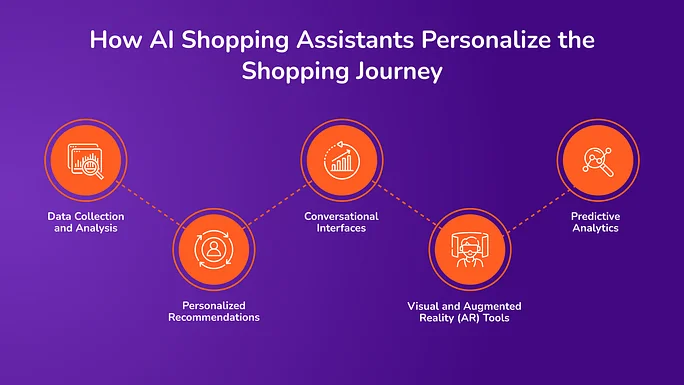
AI shopping assistants personalize the shopping journey by understanding customers’ preferences, behavior, and needs to deliver tailored recommendations and support. Here is a detailed explanation of how these shopping assistants operate:
1. Data Collection and Analysis
AI shopping assistants rely on structured and unstructured data to understand individual shopper preferences. This process starts with collecting key user data from multiple sources:
- Browsing History: The assistant monitors pages viewed, search terms used, time spent on products, and click behavior. Analyzing this data can help infer the shopper’s interests and intent. For example, repeated views of sports shoes suggest a strong buying intent in that category.
- Purchase History: AI systems examine past transactions to identify buying patterns. If a user frequently buys eco-friendly products or a specific brand, the assistant prioritizes similar items in future recommendations.
- Demographics and Preferences: AI systems use account-level data such as age, gender, location, and self-declared preferences. This enables contextual customization, such as suggesting seasonal wear based on the user’s region.
These inputs are processed using data mining and behavioral analytics algorithms to create a unique profile for each shopper.
2. Personalized Recommendations
AI shopping assistants use different recommendation systems to match users with products they are likely to purchase:
- Collaborative Filtering: This model recommends products based on users’ preferences and similar shopping behavior. For example, if User A and User B bought Item X, and User A also bought Item Y, the system might recommend Item Y to User B.
- Content-Based Filtering: This approach analyzes product attributes and matches them to the user’s preferences. If a user shows interest in black leather jackets, the assistant recommends other jackets with similar features, regardless of what other users bought.
- Hybrid Models: These systems combine collaborative and content-based filtering to improve accuracy. They account for both user-specific behaviors and product similarities. Hybrid models reduce cold-start problems and improve performance in real-time personalization.
Machine learning algorithms continuously update these models based on new user data and feedback.
3. Conversational Interfaces
Conversational AI allows users to interact with shopping assistants using text or voice commands. This interface simplifies product discovery and support:
- Chatbots and Voice Assistants: These tools offer real-time assistance by responding to queries, navigating product categories, and providing recommendations. They use Natural Language Understanding (NLU) to interpret questions and generate responses.
For example, Gemini integrates across Google services to enhance the shopping experience by answering product-related questions and offering personalized options during searches.
4. Visual and Augmented Reality (AR) Tools
Computer vision and AR technologies improve the visual aspect of shopping:
- Virtual Try-Ons: These tools use facial recognition and 3D modeling to allow users to see how apparel, makeup, or accessories look on them. This reduces uncertainty and return rates for items like sunglasses or lipsticks.
- Smart Mirrors: In physical stores, smart mirrors equipped with cameras and AR overlays simulate clothing fit and style, enabling users to try outfits virtually without changing.
Both technologies enhance decision-making by providing a visual preview before purchase.
5. Predictive Analytics
Predictive analytics uses historical data and statistical models to forecast user behavior and optimize pricing strategies:
- Anticipating Needs: The system uses time-series data and past purchasing cycles to predict future interests. For instance, if a user buys school supplies every August, the assistant may suggest new deals or popular items in late July.
- Dynamic Pricing: AI adjusts product prices in real time based on user demand, inventory levels, competition, and buying likelihood. This involves algorithms that factor in behavioral segmentation, product elasticity, and competitor monitoring.
These techniques help retailers stay competitive and offer value-based pricing tailored to individual user profiles.
The Real Benefits of AI Shopping Assistants: What Businesses Should Know
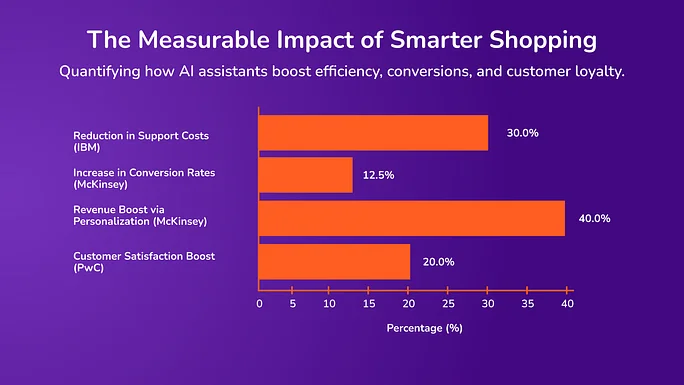
Below are the real benefits of AI shopping assistants that businesses should understand to enhance customer experience, improve efficiency,
1. Enhanced Operational Efficiency
According to IBM, businesses implementing AI chatbots saw a 30% reduction in customer service costs. AI shopping assistants automate repetitive tasks such as answering common customer questions, managing product recommendations, and processing returns.
This reduces the workload on customer support teams and allows retailers to handle a higher volume of inquiries with fewer resources.
2. Data-Driven Insights
Through AI tools, retailers gain valuable insights into customer behavior. These systems track purchasing patterns, preferences, and user interactions, helping businesses understand what drives sales.
The data gathered can be used for inventory planning, marketing campaigns, and personalized promotions, resulting in better decision-making.
3. Competitive Advantage
AI tools enable retailers to respond faster to customer needs and market changes. With personalized features and real-time support, businesses can differentiate themselves from competitors that rely on less adaptive systems.
As more consumers demand tailored experiences, AI-driven support will become a key factor in staying relevant and gaining customer trust.
Real-World Examples and Case Studies of AI Shopping Assistants
Below are real-world examples and case studies demonstrating how AI shopping assistants are successfully implemented to enhance customer experiences and drive business results.
1. Sephora Virtual Artist
Sephora’s Virtual Artist combines Augmented Reality (AR) and Artificial Intelligence (AI) to help users try on makeup products virtually through their mobile devices. The tool uses facial recognition to map a customer’s face and overlay products like lipstick, eyeshadow, and foundation in real time.
This removes the guesswork and allows consumers to see how products will look before purchasing. For Sephora, it reduces product returns and boosts online engagement by offering a more interactive shopping experience.
2. Amazon’s Rufus
Amazon’s Rufus is a conversational shopping assistant powered by generative AI and natural language processing (NLP). It is integrated into the Amazon mobile app. It allows users to ask questions in plain language, like “What are good headphones for working out?”—to receive personalized product suggestions, comparisons, and buying tips.
Rufus speeds up and simplifies the product search process for consumers, especially those unsure of what they need. For Amazon, it helps guide purchasing decisions, improves product discovery, and increases conversion rates by more effectively matching users with relevant items.
3. Walmart’s Shopping Assistant
Walmart’s AI-powered shopping assistant uses machine learning, chatbot technology, and voice recognition to assist customers across its mobile app and website. It can help users build grocery lists, reorder frequently purchased items, and find products based on previous purchases or dietary preferences.
This reduces shopping time and simplifies repeat orders for consumers. For Walmart, it improves customer retention and drives sales by encouraging recurring purchases and offering a smoother online and in-store shopping experience.
Challenges and Ethical Considerations in AI Shopping Assistants
Despite these benefits, businesses must address several challenges and ethical considerations when implementing AI shopping assistants, particularly around data privacy, user trust, and responsible AI usage. Here are a few of these challenges:
1. Data Privacy Concerns
AI shopping assistants rely heavily on personal data, including browsing history, purchase behavior, and demographic information, to deliver personalized recommendations. This raises serious privacy concerns. If not handled properly, sensitive data can be exposed, misused, or shared without user consent.
Companies must comply with data protection regulations like GDPR or CCPA and ensure strong data encryption, secure storage, and transparent user consent mechanisms. Protecting user information builds trust and reduces the risk of legal and reputational damage.
2. Algorithmic Bias
AI systems can unintentionally reflect or amplify biases present in the data used to train them. For example, product recommendations may favor certain brands, price ranges, or demographic groups, leading to an uneven or discriminatory user experience.
To prevent this, developers must carefully audit and test algorithms for fairness. Using diverse training data, applying bias detection tools, and conducting regular performance reviews are essential to ensure that the AI serves all users equally.
3. Over-Reliance on Automation
While AI assistants improve efficiency, relying too much on automation can negatively affect customer experience. Automated systems may struggle with complex queries or emotional contexts that require human understanding.
Retailers must strike a balance between AI tools and human customer support. Including clear escalation paths, where a human agent takes over when needed, ensures that customers receive the appropriate level of service.
4. Transparency
Consumers have a right to understand when and how AI is used in their shopping experience. Lack of transparency can create confusion or distrust. Retailers should disclose when AI systems drive recommendations, pricing, or decisions.
They should also explain key suggestions when possible. Explainable AI (XAI) methods can help users understand the logic behind AI outputs without needing technical knowledge.
Future Trends Transforming AI Shopping Assistants
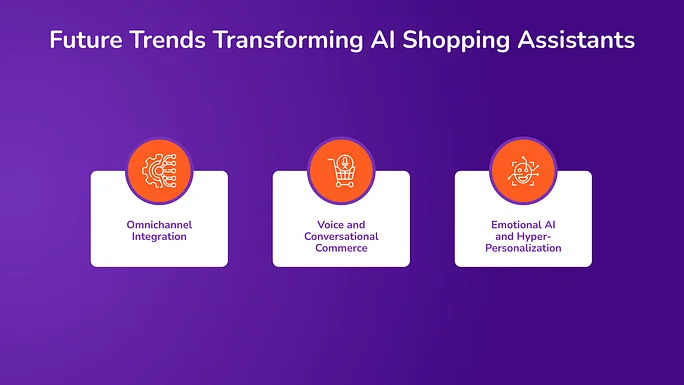
Below are the future trends expected to shape and transform how AI shopping assistants evolve and enhance the shopping experience in the years ahead.
1. Omnichannel Integration
AI shopping assistants are evolving to provide consistent and connected experiences across multiple channels, websites, mobile apps, and physical stores.
Shoppers expect to start their journey on one platform and continue it seamlessly on another. For example, a customer might search for a product using a mobile app and receive in-store availability updates or personalized in-store offers via push notifications.
Retailers like Walmart and Target have invested in AI-driven omnichannel systems that unify customer profiles and transaction history, helping AI assistants maintain continuity in personalization. According to a Salesforce report, 76% of consumers expect consistent interactions across departments and platforms, making omnichannel AI support essential for future growth.
2. Voice and Conversational Commerce
Voice-assisted shopping is expanding quickly due to the increasing adoption of smart speakers and voice-enabled mobile devices. AI-powered assistants like Alexa, Google Assistant, and Siri enable users to search for products, check order statuses, and make purchases using voice commands.
Statista forecasts that the value of voice-based shopping will reach over $40 billion by 2025, up from just $2 billion in 2018. This growth is driven by convenience, especially in hands-free scenarios like driving or multitasking at home. Retailers are responding by optimizing product listings for voice search and developing conversational interfaces that understand natural language.
3. Emotional AI and Hyper-Personalization
Emotional AI can recognize and respond to human emotions by analyzing voice tone, facial expressions, or text input. AI can adjust recommendations or tone based on a user’s emotional state while shopping.
For instance, if a chatbot detects frustration in a customer’s messages, it can change its approach and offer assistance instead of upselling. Major tech companies like Microsoft and Affectiva are developing emotion recognition APIs that retailers can integrate into virtual assistants. While this technology is still in the early stages of retail adoption, it shows potential to improve user experience and engagement.
From Automation to Compliance: How Avahi Powers Smarter Operations
Organizations across sectors seek ways to deliver an intelligent, personalized experience while maintaining data privacy and operational efficiency. However, challenges like fragmented systems, rising user expectations, and the need to manage large volumes of data make this problematic.
The Avahi AI platform offers a powerful solution for helping businesses harness the full potential of artificial intelligence without needing to manage multiple disconnected tools.
Avahi’s platform includes a modular suite of features, each tailored to address key needs across modern digital operations:
1. Smart Assistant

Provides real-time support, product or service recommendations, and contextual help through conversational AI interfaces, reducing human workload and improving user satisfaction.
2. Face Recognition
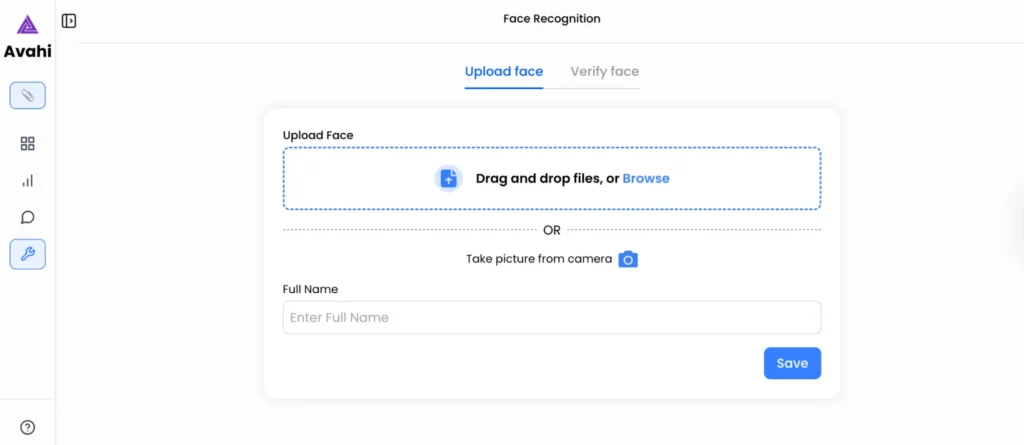
Enables identity verification, user-specific personalization, and secure access across digital or physical interfaces.
3. Image Generation
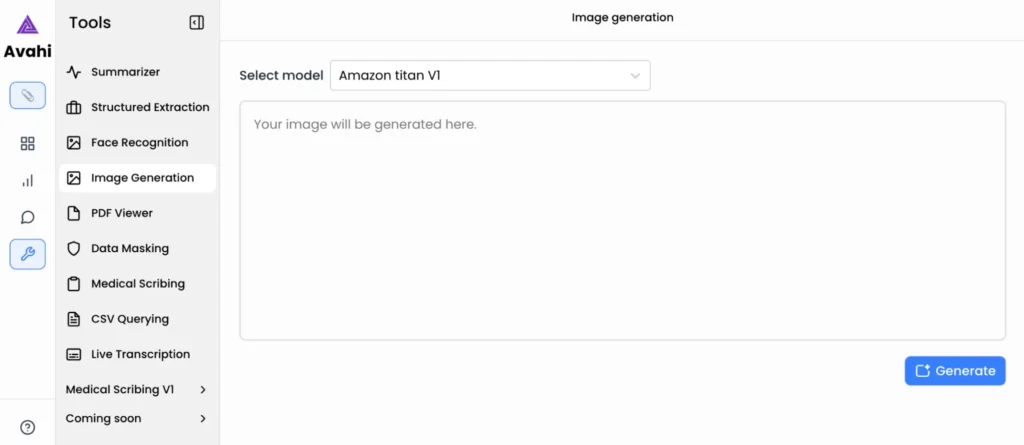
It automatically creates high-quality visuals using AI, which can be used for marketing, prototyping, simulations, or creative content production.
4. Structured Data Extraction

This extracts meaningful information from unstructured sources like documents, images, and web content, accelerating workflows such as data entry, analysis, and system integrations.
5. Data Masking

Protects sensitive information by anonymizing or encrypting personal data during processing or machine learning tasks, ensuring compliance with privacy laws such as GDPR and CCPA.
By combining these capabilities into a single platform, AvahiGenAI helps businesses streamline operations, improve user engagement, and build trustworthy, AI-powered systems while minimizing complexity and ensuring compliance.
Discover Avahi’s AI Platform in Action
At Avahi, we empower businesses to deploy advanced Generative AI that streamlines operations, enhances decision-making, and accelerates innovation—all with zero complexity.
As your trusted AWS Cloud Consulting Partner, we empower organizations to harness AI’s full potential while ensuring security, scalability, and compliance with industry-leading cloud solutions.
Our AI Solutions include
- AI Adoption & Integration – Utilize Amazon Bedrock and GenAI to enhance automation and decision-making.
- Custom AI Development – Build intelligent applications tailored to your business needs.
- AI Model Optimization – Seamlessly switch between AI models with automated cost, accuracy, and performance comparisons.
- AI Automation – Automate repetitive tasks and free up time for strategic growth.
- Advanced Security & AI Governance – Ensure compliance, fraud detection, and secure model deployment.
Want to unlock the power of AI with enterprise-grade security and efficiency? Get Started with Avahi’s AI Platform!
Frequently Asked Questions(FAQs)
1. What is an AI shopping assistant, and how does it work?
An AI shopping assistant is an intelligent digital agent that helps customers during their shopping journey by offering personalized recommendations, answering questions in real time, and guiding them through the purchase process. It uses natural language processing (NLP), machine learning (ML), computer vision, and predictive analytics to understand customer behavior, preferences, and intent. It then responds with tailored support across online and offline platforms.
2. How do AI shopping assistants differ from traditional chatbots?
While traditional chatbots follow rule-based scripts and predefined responses, AI shopping assistants are powered by machine learning and NLP. This allows them to understand natural language, learn from user behavior, and adapt to context.
They offer more intelligent, personalized, and dynamic interactions, beyond answering basic queries to providing product suggestions, cart assistance, and even upselling or cross-selling options in real time.
3. Can AI shopping assistants help reduce cart abandonment?
Yes, AI shopping assistants can significantly reduce cart abandonment. By providing real-time assistance, answering last-minute questions, reminding customers of unpurchased items, and offering personalized incentives or discounts, these assistants address common friction points that lead shoppers to abandon their carts.
Predictive algorithms can also send time-based follow-up reminders or product nudges to re-engage users who drop off mid-journey.
4. Are AI shopping assistants safe from a data privacy standpoint?
If implemented responsibly, AI shopping assistants can be safe and compliant. Businesses must adhere to data protection regulations like GDPR or CCPA, anonymize sensitive data using data masking, and provide transparent consent mechanisms.
5. How do AI shopping assistants personalize recommendations?
They analyze multiple data points, such as browsing and purchase history, demographics, declared preferences, and real-time user behavior on the platform.
Using collaborative filtering, content-based filtering, or hybrid recommendation models, the AI suggests products that align closely with the user’s interests. Over time, machine learning models refine these suggestions for improved accuracy and relevance.

